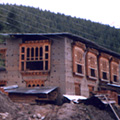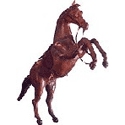Jinzo includes
- the making of religious statues and ritual objects
- pottery and
- the construction of buildings using mortar, plaster and rammed earth.
RELIGIOUS STATUES – CLAY STATUES OR FIGURES
Every temple has large statues of various Buddhist deities and also several small statues of divinities placed in small niches. The sculptured images, like thangkas, vary greatly in size from ten cm or so in height to ten metres or even more and must be consecrated before they can become objects of worship. Bhutanese tradition maintains that making images of deities is a pious act and leads to salvation.
The tradition of commissioning and making large statues has been carried on in Bhutan in the plastic medium of clay since the 7th century. These sculptures are formulated on the iconographic principles of Buddhist art. The practice of making gigantic figures in clay seems to have originated in Central Asia where, in the absence of stone quarries, the only available medium, viz, clay was used. These statues were profusely painted and gilded to give an appearance of metal and wrapped in robes appropriate to the status and significance of the divinities. This gilded patina was renewed annually.
The practice of gilding figures of clay was replaced by that of covering them with thin plates of metal, beaten into shape and designed to cover the entire figure except the face.
The statues, made of clay, have a hollow interior. The hollow within is filled with sacred writings and other objects at the time of consecration. Sometimes trees are carved in clay or wood and statues placed on the different branches on all four sides. Such groups of spiritually related divinities and saints are referred to as “Assembly Fields” and are often used as altars.
Clay tablets
The ashes of a deceased are usually scattered in the river or mixed with clay to become votive tablets called tsatsa or enshrined in a stupa or chorten.
Torma
Images and other decorations as votive offerings known as torma are also made with butter mixed in different colours. This art is practiced mainly by the monks. In temples devoted to guardian deities, these votive offerings are made solely of butter mixed with honey, and are later put on roofs for the crows to devour.
Construction of buildings
Traditional architecture in Bhutan is characterized by the use of natural locally available and ecologically sound materials such as rammed earth, bamboo, local timbers, and stone. Even today a building is made by hand with the help of a few tools only.

Walls of rammed earth
Houses are traditionally rectangular and spaces are normally laid out in squares and rectangles. Traditional walls are constructed mainly of rammed earth or stone masonry, finished with plaster. The inner walls are of closely woven bamboo matting.
POTTERY
Pottery in Bhutan is made by hand and not on the wheel. Cooking pots, vessels for fermenting the local liquor, flower pots, pots for storage of water. Today, experimentation with the wheel to make products and glazing of objects are being done.
PRODUCTS
Idols Tara, incense holder, masks and tea pot.
Gallery
YOUR VIEWS
PRACTITIONERS: INDIA
Access 70,000+ practitioners in 2500+ crafts across India.
BIBLIOGRAPHY
10,000+ listings on arts, crafts, design, heritage, culture etc.
GLOSSARY
Rich and often unfamiliar vocabulary of crafts and textiles.
SHOP at India InCH
Needs to be written.





